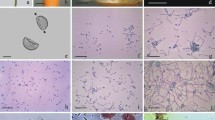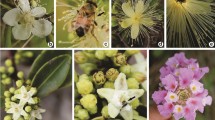Summary
This study has compared mature pollen grains while still in the anther, as well as post-pollination responses, from untreated and CHATM Chemical Hybridizing Agent-treated wheat plants using light (bright-field, phase-contrast, and fluorescence), scanning, and transmission electron microscopy. The chemical, azetidine-3-carboxylic acid (A3C), was applied at three treatment levels of 0.75, 1.0 and 1.5 kg/ha for the mature pollen investigations. It was found that the major effect of A3C on mature pollen is an alteration of the wall precursor vesicles (wp-vesicles), which form a high proportion of the contents of the mature grass pollen grain. The degree of deformation of the wp-vesicles is dose dependent. There is some evidence that increased aggregations of ribosomes are formed in treated pollen cytoplasm. Pollination studies (all at a treatment level of 1.0 kg/ha) show that, in most cases, the treated pollen does not germinate, and a high percentage of the pollen grains burst (60% burst grains in treated material compared to 28% in controls). In about 20% of the cases from treated plants, a short pollen tube forms, but no tubes were seen to grow far enough to enter the stigma hairs of the pistil. Thus, A3C does not act by preventing pollen formation, but by the prevention of normal pollen tube growth. There appears to be a specific targeting of the wp-vesicles such that, even in cases where the ultra-structure of the vesicles is not altered, the normal course of events leading to the incorporation of their contents into the extending tube wall is arrested. Further studies must be undertaken to determine the significance of the effect of CHATM Chemical Hybridizing Agent on wp-vesicle composition.
Similar content being viewed by others
References
Bowles DJ, Lemle L, Kauss H (1977) Glycosylation of sterols and polyphenolphosphate in the Golgi apparatus of Phaseolus arreus. Planta 134:177–181
Cass DD, Peteya DJ (1979) Growth of barley pollen tubes in vivo. I. Ultrastructural aspects of early tube growth in the stigmatic hair. Can J Bot 57:386–396
Chandra S, Bhatnagar SP (1974) Reproductive biology of Triticum. II. Pollen germination, pollen tube growth, and its entry into the ovule. Phytomorphology 24:211–217
Colhoun CW, Steer MW (1983) The cytological effects of the gametocides ethrel and RH-531 on microsporogenesis in barley, Hordeum vulgare. Plant Cell Environ 6:21–30
Gellately JBM, Martin JG (1987) Use of carboxylic azetidine derivatives for reducing blood cholesterol levels. European patent no 208347
Herman EM, Platt-Aloia KA, Thomson WW, Shannon LA (1984) Immunochemical and cytochemical evidence for an intracellular role for plant Golgi apparatus. In: Dugger WM, Bartnicki-Garcia S (eds) Structure, function and biosynthesis of plant cell walls. Waverly Press, Baltimore, Md, pp 435–443
Heslop-Harrison J (1983) Self-incompatibility: phenomenology and physiology. Proc R Soc London Ser B 218:371–395
Heslop-Harrison J, Heslop-Harrison Y (1982a) The growth of the grass pollen tube. I. Characteristics of the polysaccharide particles (“P-particles”) associated with apical growth. Protoplasma 112:71–80
Heslop-Harrison J, Heslop-Harrison Y (1982b) The pollen-stigma interaction in the grasses. IV. An interpretation of the self-incompatibility response. Acta Bot Neerl 31:429–439
Jensen WA (1984) The effect of a chemical hybridizing agent on the development of wheat pollen. In: Willemse MTM, Van Went JL (eds) Sexual reproduction in seed plants, ferns and mosses. Pudoc Press, Wageningen, p 34
Juniper BE, Cox GC, Gilchrist AT, Williams PR (1970) Techniques for plant electron microscopy. Blackwell, Oxford London
Krolak JM, Taylor N, Dashek WV, Mills RR (1977) Azetidine-2-carboxylic acid induced suppression of [14C]proline incorporation into cytoplasmic macromolecules and cell walls of Lilium longiflorum pollen. In: Malik CP (ed) Advances in plant reproductive physiology. Kalyani Publishers, New Delhi, 67–71
Ladyman JAR, Mogensen HL (1987) Studies on the mode of action of a chemical hybridizing agent. Agron Abst Crop Sci Division, p 69
Lercher M, Wojciechowski ZA (1976) Localization of plant UDH-glucose: sterol glucosyltransferase in the Golgi membranes. Plant Sci Lett 7:337–340
McRae DH (1983) Advances in chemical hybridization. Plant Breed Rev 3:169–191
Mogensen HL (1971) A modified method for re-embedding thick epoxy sections for ultramicrotomy. J Ariz Acad Sci 6:249–250
Olvey J (1983) Process for the hybridization of cotton. UK patent 2112617. Application no 8300019
Orci L, Montesano R, Meda P, Malaisse-Lagae F, Brown D, Perrelet A, Vassalli P (1981) Heterogeneous distribution of filipin-cholesterol complexes across the cisternae of the Golgi apparatus. Proc Natl Acad Sci USA 78:293–297
Reynolds ES (1963) The use of lead citrate at high pH as an electron opaque stain in electron microscopy. J Cell Biol 17:208–212
Rosen WG (1968) Ultrastructure and physiology of pollen. Annu Rev Plant Physiol 19:435–462
Rosen WG, Gawlik SR (1966) Fine structure of lily pollen tubes following various fixation and staining procedures. Protoplasma 61:181–191
Rosen WG, Gawlik SR, Dashek WW, Siegesmund KA (1964) Fine structure and cytochemistry of Lilium pollen tubes. Am J Bot 51:61–71
Rowell PL, Miller DG (1971) Induction of male sterility in wheat with 2-chloroethylphosphonic acid (Ethrel). Crop Sci 11:629–631
Schulz PJ, Almeda E (1988) The effects of chemical hybridizing agents (Sogetal, Inc, Hayward, CA) on the ultrastructure of developing wheat anthers (Triticum aestivum L. var ‘Yecora rojo’). Am J Bot (abstr) 75, part 2:46
Shivanna KR, Heslop-Harrison Y, Heslop-Harrison J (1982) The pollen-stigma interaction in the grasses. III. Features of the self-incompatibility response. Acta Bot Neerl 31:307–319
Spurr AR (1969) A new low viscosity resin embedding medium for electron microscopy. J Ultrastruct Res 26:31–43
Stanley RG, Linskens HF (1974) Pollen. Springer, Berlin Heidelberg New York, pp 150–153
Virmani SS, Edwards IB (1984) Current status and future prospects for breeding hybrid wheat and rice. Adv Agron 36:145–214
VanDerWoude WJ, Morre DJ, Bracker CE (1971) Isolation and characterization of secretory vesicles in germinated pollen of Lilium longiflorum. J Cell Sci 8:331–351
Author information
Authors and Affiliations
Rights and permissions
About this article
Cite this article
Mogensen, H.L., Ladyman, J.A.R. A structural study on the mode of action of CHATM Chemical Hybridizing Agent in wheat. Sexual Plant Reprod 2, 173–183 (1989). https://doi.org/10.1007/BF00192764
Issue Date:
DOI: https://doi.org/10.1007/BF00192764




